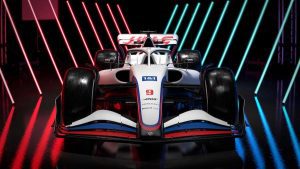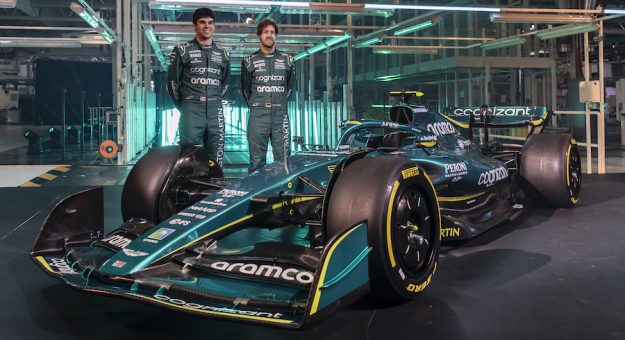This year’s Formula 1 technical regulations represent one of the most sweeping changes since the FIA world championship began in 1950.
“It feels like a very long time ago the FIA officially unveiled the regulations for the future of the sport,” said Ross Brawn, Formula 1’s managing director of motorsport, “but after the one-year delay due to the pandemic we will see the next generation of F-1 cars take to the track.
“There is huge excitement ahead of this new era and while 2021 was a great battle we still had cars struggling to follow each other during the race. The new regulations will address this problem and create an opportunity for closer battles and more wheel-to-wheel racing,” Brawn added. “The combined effect of the new aerodynamic regulations and financial rules, in the form of the cost cap, will create conditions for a more balanced championship and for the gaps across the grid to close.”
The 2021 F-1 cars lost 45 percent of their downforce when they were within a car’s length of the car in front. This makes following a car closely, especially in fast corners, and overtaking very difficult. The 2022 cars will lose only 15 percent of their downforce in those situations.
Nikolas Tombazis, the FIA’s single-seater technical director, said: “2022 will herald a new era for the FIA Formula 1 world championship, with the introduction of one of the biggest changes in regulations in the history of the sport. The FIA has led a superb collaborative effort with Formula 1 and the teams to identify the areas we feel will have the biggest impact on the ability of the cars to race each other closely on the track, and in combination with the financial regulations that are already in place, these new technical regulations should have a great positive impact on the spectacle but also on the sustainability of our sport.”

KEY OBJECTIVES
Among the key objectives for 2022 are: race-ability — enable and facilitate close racing; competitive grids —reduce gaps between the cars; financial sustainability — improve the financial health of the sport by creating a sustainable business model and reducing cots; environmental sustainability — contribute to a technological progress in road-relevant areas; and aesthetics/passion — create great-looking, exciting cars.
The aims of the aerodynamic regulations are: wake performance — close racing; simplification of the car; de-sensitization of certain areas — leading to lower performance differentials; simpler front wing with weaker vortices — less able to control front-wheel wake; no barge boards; and ground effects car — long diffuser under the side pod.
Some of the areas where the 2022 cars will differ visually from the 2021 models are the nose, front wing and endplates, engine intake, sidepod intake shape, sidepod coke shape and engine cover spine, brake ducts, rear wing and endplates.
F-1 chief technical officer Pat Symonds revealed that the simulations used to create the final 2022 concept were the equivalent to 471 years’ worth of computing on older, less-advanced computer simulators.
Fans should not, however, expect an “overnight” improvement to the racing.
CHAMPION’S VIEW
Mercedes did not win last year’s world driving championship with Lewis Hamilton after the controversial last lap of the Abu Dhabi Grand Prix handed the title to Red Bull’s Max Verstappen. But Mercedes did clinch a record eighth Constructors’ world championship.
Mercedes would like to make that nine this year, but like the other nine teams it had to start the design of its 2022 car with a clean sheet of paper.
Mercedes chief technical officer James Allison said during the offseason: “We’ve been buried in them (the regulations) and the reality of making them real for so long, that it’s easy to forget sometimes just what a massive set of regulation changes these 2022 rules represent.
“I’ve been working in the sport for over 30 years and they dwarf anything else I’ve ever seen. I suspect if I were to dig out Wikipedia and go through every season of the sport that there’s ever been, there would be nothing to match the scale of the change that comes with 2022.”
Allison added, “The rules set is not only enormous — the regulations are about twice the size of what’s preceded them — but they’re all almost entirely different from what came before them and that has meant that we’ve had to reinvent the car tip to toe.
“Everywhere you look, it’s completely new. Not just new as in new parts, but new as in a completely new philosophy.
“A completely different aerodynamic package, different brakes, different wheels,” Allison continued. “Crucially, different tires and even the engine — one of the things which is less touched by the regulations than many — even there, the power unit has to be prepared so that it can be frozen for three years.
“All the goodness that you can possibly pack into it has to be packed into it now or forever hold your peace, because after that, changes will be very, very difficult to make real.
“It has been incredibly hard.
“It’s been a very challenging and long process to get our heads around this and to try to figure out what the best response is to these regulations, and where the opportunity is to be found on the track.”
DRIVERS’ EYES
“I like the rear of it,” Daniel Ricciardo said after examining a ’22 mockup. “The rear looks pretty old school. It reminds me of 2008, with that style which is cool. The front is very different, but like all things, the more you stare at it, the more normal it will start to look.”
“It’s interesting, very different to what we are used to,” said Verstappen. “The most important thing is that we improve the racing and can race closer. If this is the way forward, then I’m all for that.”
One of the reasons Lewis Hamilton signed a two-year contract extension last year was because he wanted to take on the challenge of developing and racing the new car.
“It’ll be amazing for the fans and the sport if it leads to better racing,” he said last year.
“I’m excited,” George Russell said of the new car. “The idea behind the changes is the right idea and I guess we just have to wait and see when it hits the track if it performs as we all hope. But it’s definitely the first time the sport’s ever had a working group toward making racing better and that, as a driver, is all we want.
“There’s been a lot of interest in making the cars just faster and faster and faster and the racing side of things has been secondary,” Russell added. “Now, everyone is really pushing to have a car that allows us to race, allows us to push, and I really think this will provide that. It is really exciting and the sport and the future is looking great.”
A PROBLEM?
Former Formula 1 driver Nico Hulkenberg, who is now the test-and-reserve driver for Aston Martin, was one of the first to drive a 2022 car in the simulator last year. He was unsure if the problem of one car being able to closely follow another car has been solved.
“They aimed to make the cars a bit slower, more challenging to drive, to have more focus on drivers that can make a difference rather than car performance and aerodynamics dominating,” Hulkenberg said.
“From my initial experience, however, the new cars are pretty damn fast and not necessarily slower than the last generation. The driving experience hasn’t changed that much either, at least in the simulator.
“It will be very interesting to see whether these cars can really follow the car in front better,” Hulkenberg noted. “In the simulator, the cornering speeds are extremely high, so the risk of dirty air is still given and it’s difficult for me to imagine that following another car comfortably at these speeds will be easy.
“Anyhow, I hope we will be positively surprised. Once preseason testing starts drivers and teams will find out how the cars really behave on-track.”
WILL IT CHANGE?
Will the teams make changes to their cars after they see the solutions other teams have come up with?
McLaren’s technical director James Key said, “Teams will come up with various solutions based on a lot of time on development. So we will see differences, refinements and detailing.”
But Red Bull team principal Christian Horner commented, “The regulations are so tight now that the variance between the cars will really be quite minimal and the differences will no doubt be under the skin of the car. It is kind of a shame that we are going down a route where the shape is so constrained, and it will be the livery that will be the biggest differentiator between the cars. They are kind of retro-looking. It sort of looks like a ’90s Indy car. I think the car looks pretty cool, but it looks pretty retro.”
